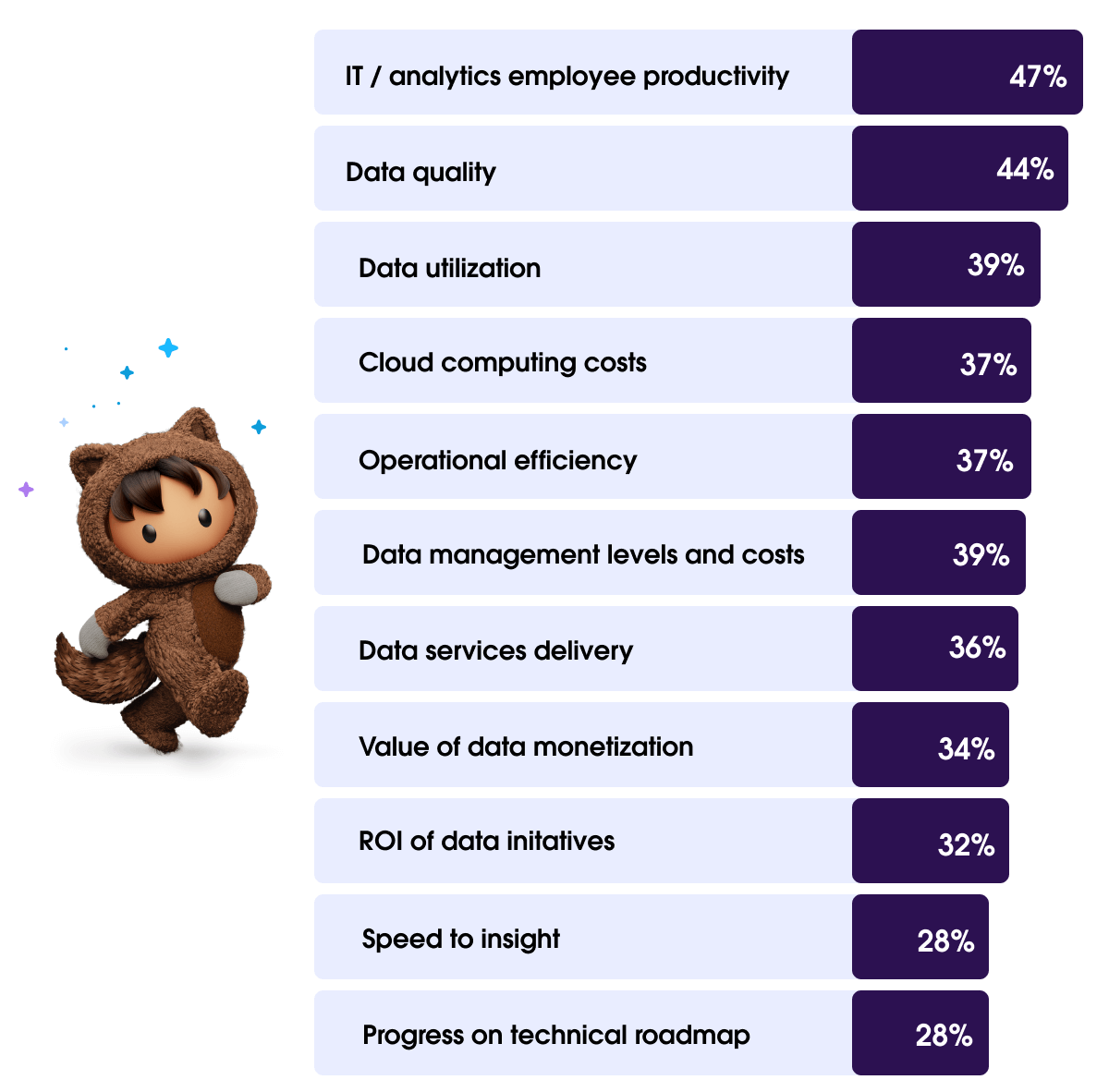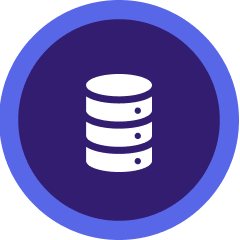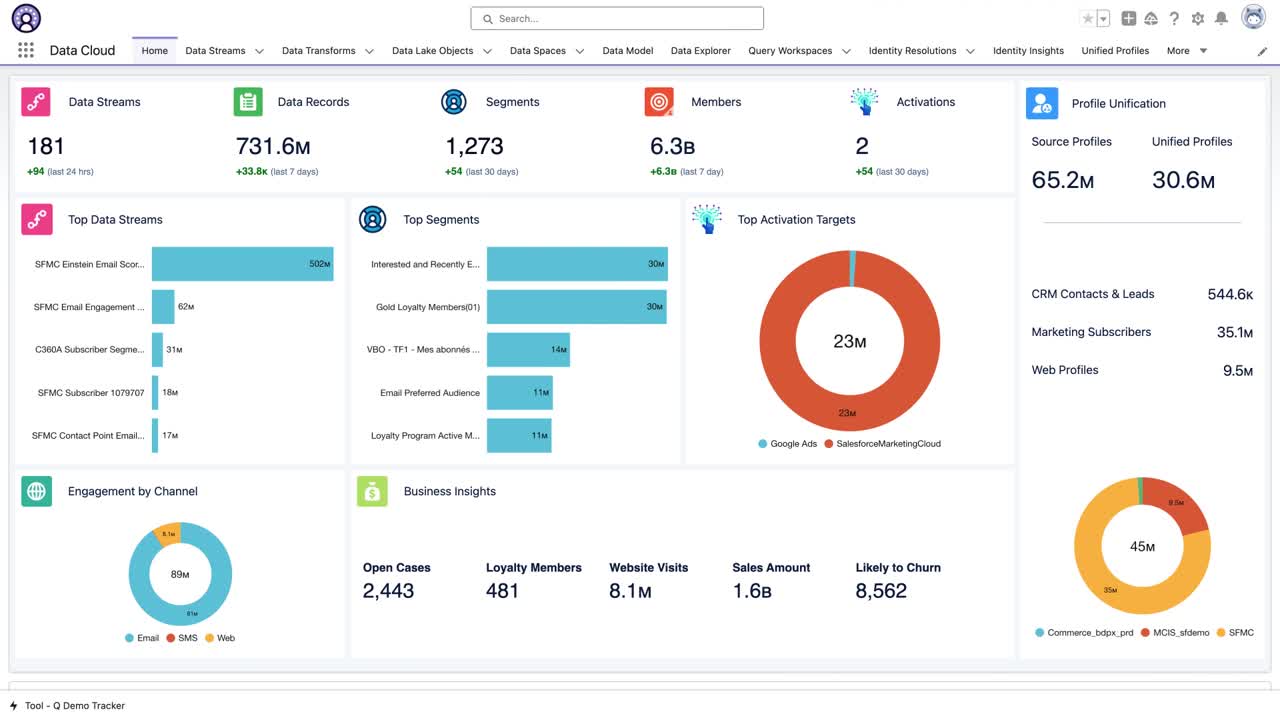Guide
Data Strategy Guide
How to Transform Information into Innovation


The path to AI success begins and ends with quality data.
Business, IT, and analytics decision makers with high data maturity were 2x more likely than low-maturity leaders to have the quality data needed to use AI effectively, according to our State of Data and Analytics report. “What’s data maturity?” you might wonder. Hang tight, we’ll explain in chapter 1 of this guide.
Data-leading companies also experience:
- 41% improvement in time to market
- 89% improvement in customer acquisition and retention
- 45% boost in employee retention
Your data strategy isn’t just important, it’s critical in getting you to the head of the market with new AI technology by your side. That’s why this guide is based on recent industry findings and provides best practices to help your company get the most from your data.
Chapter 1
Focus on Data Maturity
Data maturity is the fastest route to AI success.
But what exactly does data maturity look like? Organizations reach the pinnacle of data maturity when:
- Data strategies complement business goals. Your stakeholders use data to guide every strategic move, enabling you to transform insights into actionable plans and measurable achievement.
- Your customers benefit from your data-centric approach. Deep insights help you anticipate their needs — even before your customers are fully aware of them — and provide customized experiences.
- Security and trust underpin every data initiative, with organization-wide standards to ensure that your data, and your customers’ data, is always protected.
The path to achieving data maturity requires a commitment to:
- Create a data strategy where business and data teams agree on how to use data to advance business goals
- Establish data management and governance to ensure data integrity and trust
- Adopt data solutions that transform data into meaningful insights
- Prioritize data security to protect data from breaches and maintain compliance
- Build a data culture so every employee has the skills they need to see, understand, and act on data insights
See how John Lewis & Partners uses CRM + AI + Data to personalize customer experiences:
Tableau Product Manager at John Lewis & PartnersInvesting in Salesforce has enabled us to make decisions faster and develop deeper relationships with our customers by providing a more personalized, convenient, and seamless customer experience.
Libby Hickey
Sound data strategy starts with the right blueprint.
- Take our free assessment.
- Establish a baseline and understand your data maturity.
- Track progress, monitor growth, and identify areas for improvement.
- Get specific recommendations and accelerate your data transformation.
Chapter 2
Align strategy and goals
Bridge the gap between data and business success:
Aligning data strategies with business goals is easier said than done. In fact 41% of line-of-business leaders say their data strategy has only partial or no alignment with business objectives.
Here are five ways to bridge the gap and make data work for your business.
1. Define your business goals. Collaborate with a core team of business and IT stakeholders to identify and prioritize the objectives you’re trying to achieve with data. Prioritize goals that are foundational to your business success, such as revenue growth, customer satisfaction, cost reduction, and market expansion. Here are some ways that data can support these goals:
| Business Goal | Data Use Case |
|---|---|
| Revenue Growth | Use data analytics to identify and target high-value customer segments, leading to increased sales and revenue. |
| Customer Satisfaction | Use trusted customer data to personalize experiences and provide tailored recommendations, enhancing satisfaction and loyalty. |
| Cost Reduction | Analyze operational data to identify inefficiencies and streamline processes, resulting in cost savings and improved profitability. |
| Market Expansion | Examine market trends and customer preferences to identify new opportunities and strategies for expansion into new markets. |
2. Determine your key metrics. The key performance indicators (KPIs) you choose should measure progress toward your business goals, as demonstrated in the examples below.
| Business Goal | Data Use Case |
|---|---|
| Revenue Growth | Conversion Rate: Measure the percentage of potential customers who are converted into paying customers. |
| Customer Satisfaction | Customer Retention Rate: Track the percentage of customers who continue to do business with the company over a specific period. |
| Cost Reduction | Operational Efficiency Ratio: Compare the cost of operations to the revenue generated. |
| Market Expansion | Customer Acquisition Rate: Track the rate at which new customers are acquired. |
3. Assess your resources and budget. Determine if you have the systems, tools, and budget in place to carry out your goals. For example, your goals may require you to invest in a more advanced CRM or data analytics platform to track specific KPIs. If you have goals around personalizing customer experiences, you may determine that you need to invest in solutions like Data Cloud to unite all your customer data and use it to serve them better. This assessment will help you determine what’s realistic for your business.
4. Build a strong data culture. Data is a team sport, and your teams will need the skills to understand and use data. This may require additional investments in training and change management initiatives to get teams accustomed to a new way of working.
See how F5 is building a data culture with Tableau:
Former RVP of Enterprise Data Strategy and Insights at F5Data has been transforming our corporate culture, right in front of our eyes. I feel like every morning, I wake up, and I’m learning something new about data.
Amie Bright
Checklist for aligning teams in your organization:
- Collaborate with business and IT stakeholders to identify and prioritize business objectives.
- Develop the organization’s key data KPIs by working with a wide spectrum of internal teams.
- Survey team leaders to determine if you have the systems, tools, and budgets to achieve your goals.
- Invest in nurturing the skills and behaviors your teams need to understand and use data for business advantage.
- Consider joining a community like the Data Leadership Council (DLC) to gain advice and best practices on ways to drive data cultures.
Chapter 3
Prioritize data quality
Prepare your data governance strategy.
Eighty-six percent of analytics and IT leaders agree that AI’s outputs are only as good as its data inputs. They know that high data quality brings organizations closer to data maturity and AI success. So how can you improve the quality of your data? It starts with data governance.
92%
of analytics and IT leaders agree there’s never been a greater need for trustworthy data.
*The State of Data and Analytics Report, 2023
Data governance is the combination of controls, roles, and repeatable processes that create trust and confidence in your organization’s data and analytics. Governance helps build a culture of trust around data. When your people know the data they’re using is reliable, they can be more confident about their decisions.
Follow these six steps to lay the groundwork for a successful governance strategy:
-
Meet with relevant stakeholders and learn what data they need to do their jobs. Ensure that your governance policies cover every critical use case and workflow. Knowing how your teams are using data will inform every aspect of your strategy.
-
Define what ‘data quality’ means in your organization. Consider these key criteria in your definition:
- Completeness: Do your records include all necessary data fields?
- Timeliness: Does the data represent the current state of the business and its strategic goals? Is the data updated regularly?
- Validity: Does the data follow governance rules, constraints and guidelines?
- Usage: How often is this data used for reporting and in applications?
- Accuracy: Are your data sets regularly updated from trusted sources? Does the data accurately reflect what it’s intended to represent?
- Consistency: Are data formatting standards required across all data sources or even within the same dataset?
- Reliability: Has the data maintained its quality and consistency over long periods of time?
-
Develop a comprehensive quality control process. Standardized processes for data entry, cleansing, deduplication, merging, and archiving are part of effective data governance. Take advantage of AI-powered data-cleansing tools, like Tableau CRM Analytics, for built-in deduplication, validation, and enrichment data-profiling features.
-
Plan for regular governance review and updates. Because your business is constantly evolving, it’s important to revisit your existing governance strategy. Make sure to schedule time for updates.
-
Educate everyone in your organization about data handling requirements. Assign security and permissions to maintain confidentiality and ensure regulatory compliance. And create a way for employees to report and resolve data-related issues as they arise, such as a dedicated Slack channel.
-
Establish success metrics. Success metrics are the best way to identify areas of improvement and encourage data-driven decisions. For a deeper dive on data governance KPIs, see the section below.
Ease Data Management
Deliver high-quality data more efficiently with data management tools built directly into your CRM and Tableau.

Focus on data governance.
More than six in 10 analytics and IT leaders say they’re in the dark about key metrics, including data quality, data utilization and speed to insight, according to our State of Data and Analytics report. These metrics are critical as they help teams measure the effectiveness of their data initiatives.

Let’s take a closer look at the metrics to understand how each plays a role in your data strategy, and why they should be tracked:
- Data usage metrics determine how you are using data. And that usage is intertwined with your overall resources, including your people, platforms and processes.
- Data quality metrics evaluate the quality of your data against governance standards you’ve defined.
- Time-to-insight metrics help you to pinpoint bottlenecks between insights and action and work on bridging any gaps.
How do you translate those metrics into smart KPIs? Begin by establishing goals for each metric that can be measured and achieved within a specific timeframe. Then, brainstorm a way to track and report on these KPIs with your stakeholders that won’t add complexity to existing processes.
The examples below illustrate how governance metrics can be shaped into smart and trackable KPIs.
| Metric | Example of Smart KPI | How to Track |
|---|---|---|
| Data quality | Achieve a 4% improvement in data quality by the end of each quarter. | Assign values to and routinely refresh frequency, usage, prep flow completion rate, error warning rate. |
| Data usage | Increase the use of customer data for decision-making by 30% within the next 12 months. | Determine relevant metrics to measure, such as employee access/log-in rates and a frequency for tracking and reporting this data. |
| Time to insight | Decrease the average time for <customer event> to be incorporated into field-service dashboards to 10 minutes by the end of the next quarter. | Track the average time to insights against industry benchmarks or past performance. |
Associate Director, Data and Business Analysis at RBC Capital MarketsAscending along the maturity curve will bring many benefits such as higher efficiency, more successful initiatives that rely on quality data, and competitive advantage among your peers.
Funke Bishi
Checklist for promoting data quality:
- Define what quality data means for your organization.
- Meet with team stakeholders to understand what data they need to do their jobs.
- Use AI-powered data-cleansing tools, like Tableau Data Prep.
- Help key leaders understand the fundamentals of data cleaning.
Chapter 4
Secure your data
Rely on data hygiene as a key security tactic.
Analytics, IT, and business leaders cite security threats as the top barrier to successful data management, according to our recent State of Data and Analytics report. But here’s the good news: Experts agree that human error accounts for 80% of all cybersecurity incidents and that practicing basic hygiene can prevent most breaches.
Likewise, global IT and information security leaders in our recent 2023 Global Data Security Trends report basic multi-factor authentication, identity and access management, and data encryption as the most effective security protections against cyberattacks.
Understand the most effective ways companies defend against security attacks:

Let’s take a look at six security best practices, and how they can protect your most valuable strategic asset: your data.
- Data encryption
Data encryption keeps private information private by converting data into ciphertext that can only be decrypted by a decoder key. All types of data, from private messaging to financial transactions, rely on encryption to protect sensitive data. Look for encryption solutions for your data while it’s in transit and at rest. - Identity and access management
Ensure that your people have just enough access to the data and systems required to do their work — and nothing more (least privilege access). Sixty-six percent of leaders surveyed in our security report say they trust identity and access management processes to help secure their data by controlling access, reading, and editing rights. - Multi-factor authentication
Multi-factor authentication (MFA) is a layered security approach that requires you to validate your identity with two or more credentials. MFA was reported to be most effective in defending against cyberattacks, with 80% of surveyed IT leaders stating that it is a key part of their security strategy. - Backup and recovery
Only 39% of IT and infosec leaders surveyed in our security report view backup and recovery as a core component of their security strategy. Take the proactive step and invest in a solution that ensures all your data — CRM, cloud, and on-premise data — is backed up to prevent data loss. - Security awareness and training
Your team is your first line of defense against cyberattacks. Help them recognize security threats through continuous awareness training. Nearly two-thirds of IT and infosec leaders say they are providing security training to employees more frequently to drive adoption of security measures. - Password management
Deploy a secure platform to support password generation and storage and urge your employees to use strong, unique passwords that are updated regularly. Here are some password best practices to keep in mind:- Create a master password with 16-plus characters, including uppercase and lowercase letters, numbers, and symbols
- Consider using a passphrase with special characters in place of letters to optimize its security
- Ensure that signing into the password manager requires multi-factor authentication
See how Humana keeps patient data safe and saves $6 million in security costs:
Checklist for simple security measures:
- Automate software and security updates to ensure devices are protected against the latest vulnerabilities.
- Encrypt data during transmission and store it securely to prevent unauthorized access.
- Use a secure file-sharing platform with end-to-end encryption to send confidential or sensitive data.
- Give employees only enough access to the data and systems they need to do their jobs effectively.
- Maintain employee permissions only to the data and systems relevant to their roles.
Chapter 5
Unify your data silos
See why connected data makes customers happy.
65%
Almost two-thirds of customers say they expect companies to adapt experiences to match their changing needs.*
Have you ever received a marketing message for a product that you just purchased? Or perhaps you’ve been asked to detail your purchase history before being routed to the right customer service rep?
These examples of disconnected customer service experiences lead to frustrated customers and missed opportunities. And at the root of those disjointed experiences are disparate systems and data silos that make it hard to see the big picture.
With an average enterprise using over 1,000 applications, data ecosystems are incredibly complex. And while many organizations may centralize their data in data lakes, warehouses or lakehouses, it often winds up never getting fully realized. In fact, Forrester reports 73% of enterprise data goes unused for analytics.
So, what happens to this data? It remains static and stuck in back-end solutions not designed to activate data within the everyday workflows and applications business teams use to engage with their customers.
You can bridge data silos to make personalized customer experiences a key differentiator for your business. With the right data solutions, it’s possible to unify all of your customer data — from online reviews and customer service records to browsing behavior and purchase history — to drive customer success. And most importantly, you can go a step further by securely activating all your data across your CRM and using it to power AI and drive great customer experiences.
Build customer loyalty with data-driven insights.
With access to complete, unified customer profiles, every team in your organization can tap into the power of data and deliver experiences that lead to long-term customer value. Imagine the possibilities:
- Sales reps can receive near-real time guidance during customer video and voice calls and suggest personalized offers to customers.
- Service reps can offer proactive service with near-real time alerts that identify issues, and empower agents to resolve the issue.
- Marketers can create personalized messages across channels, adapting to customer behavior across various brand properties in near-real time.
- Retailers can build custom experiences that adapt in near-real time to customer actions, including abandoned shopping carts or actions taken on a website or mobile app.
- IT teams can build apps based on near-real time data, to detect fraud or analyze economic data to determine benefits.
Checkpoint: Build a holistic view of your customer.
Here are just some of the types of customer data that you can use to gain insight into your customer:

Basic data
- Demographic data, including age, gender, location, job title
- Email address
- IP address

Interaction data
- Emails opened
- Website visits
- Click-through rates (CTR)
- Chat transcripts
- Customer service calls
- Social media activity

Behavioral and Attitudinal Data
- Purchase history
- Average order value
- Newsletter sign-ups
- Online reviews
- Feedback forms
- Product satisfaction surveys
To go from raw data to actionable insights, you need a platform that can harmonize and secure all of your data — no matter where it resides — and transform it into a single and trusted source of truth. That platform is Data Cloud.
Find key customer insights with Data Cloud.
Data Cloud puts all of your data to work for your customers. It is deeply embedded in the Salesforce Platform, which means any external data lake or warehouse can now drive actions and workflows inside of your CRM. Data Cloud is about more than just bringing data together. It’s about bringing entire organizations together around the customer to improve experiences and drive growth. Data Cloud lets you:
- Connect and unify all your data without building complex data pipelines
- Activate your data with insights and automation across every customer touchpoint
- Enable trusted AI grounded with all your enterprise data
See how data increases Formula 1 fan engagement:
Senior CRM and Customer Operations Manager at F1With over 500 million fans worldwide, how do we understand who they are and continue to grow that audience? It’s those personalized journeys and always-on capabilities.
Matthew Kemp
Checklist for uniting your data:
- Make it easy to store, manage, and analyze all of your customer data, from any data source.
- Think holistically about all your customer data, including behavioral, interaction, and attitudinal data.
- Use a platform that can help your teams turn raw data into actionable insights.
- Audit your systems and software for data silos that may be causing disconnected customer experiences.
- Ensure that your data is accessible within the applications and workflows you use every day, through trusted solutions like Data Cloud.
Take the Next Step
Great AI starts with great data
Put data at the center of everything you do.
In the age of AI, strong data has moved from “nice to have” to “red alert, we need this now.” A robust data foundation is critical for the accurate and meaningful responses that AI needs to revolutionize business operations. With this foundation, you can pave the way for transformational AI use cases, while helping your team make faster, more informed decisions in their day-to-day work.
Named as a Leader in the inaugural Gartner Magic Quadrant for Customer Data Platforms, Salesforce’s Data Cloud helps you realize the true potential of your data and prepare for AI. Bringing all your data silos together and activating them ensures that AI results are grounded, accurate, and effective. Plus, Data Cloud makes data easily accessible within the applications and workflows businesses use every day, enabling teams to make faster, more informed decisions in service of your customers.








